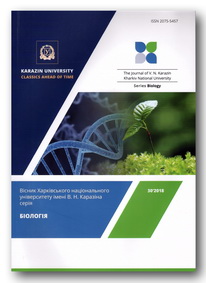Асоціація Balantidium coli і кишкових кокцидій (Eimeria, Cryptosporidium, Isospora) у свійських свиней в Азербайджані
Анотація
Мета дослідження – визначення картини поширення асоціативних інвазій у свійських свиней у фермерських господарствах. Дослідження проводилися в 2009–2015 рр. Були зібрані і проаналізовані зразки калу свійських свиней (2272 голів) різного віку в приватних фермерських господарствах у Балакененському, Загатальському, Шамахінському, Ісмаїлінському, Губинському, Хачмазькому, Худатському, Сальянському районах і на Апшеронському півострові, що входять до складу Азербайджану. Видовий склад, ступінь поширення у свиней та екологічні особливості паразитичних найпростіших на цій території раніше вивчені були. Виявлено, що асоціація інвазивності у свійських свиней у зазначених районах така: ооцисти Eimeria і Isospora виявлені у 582 свиней (25,6 %), ооцисти Eimeria і Cryptosporidium у 622 свиней (27,4 %), ооцисти Eimeria і цисти Balantidium у 273 свиней (12,0 %), ооцисти Isospora і Balantidium у 18 свиней (0,8 %), ооцисти Eimeria, Isospora і Cryptosporidium у 0,04 % свиней. З проаналізованих зразків калу жоден не містив 4-компонентну мікст-інвазію. Двокомпонентні мікст-інвазії Eimeriosis + Cryptosporidiosis і Eimeriosis + Isosporiasis відзначалися протягом усього року, рівень асоціативних інвазій Eimeriosis + Balantidiosis і Isosporiasis + Balantidiosis був нижче влітку. Утримання свиней різного віку в одному приміщенні на фермах сприяє їх зараженню різними видами паразитів, що призводить до появи асоціативних інвазій. У свинарських фермах, які оснащені різними технологічними пристосуваннями, епізоотичні ситуації паразитарних захворювань будуть різні. Таким чином, серед тварин, які утримуються традиційним чином, зараженість набагато вище. У тварин, які утримуються в непровітрюваних приміщеннях з дерев'яною підлогою, екстенсивність мікст-інвазій найбільш висока, і економічний збиток на таких фермах великий. У тварин, які утримуються в теплих приміщеннях з високою вологістю, навіть взимку екстенсивність інвазії буває високою, оскільки тепло і вологість створюють сприятливі умови для екзогенного розвитку ооцист кокцидій.
Завантаження
Посилання
Anisimova M.A. (2013). Mixed infestation of pigs (features of epizootology, complex treatment and prophylactic measures). Materials of the scientific conference "Theory and Practice of the Control of Parasitic Diseases". Moscow. Issue 14. P. 23–26. (in Russian)
Gaibova G.D., Iskenderova N.G., Hajiyeva N.A. et al. (2011). Intestinal coccidians of cattle in the Balakan-Sheki region of Azerbaijan. Actual problems of parasitology in Georgia. Tbilisi. P. 84–88. (in Russian)
Gasanova J.V. (2012). Parasitic protozoa (Protozoa, Apicomplexa) of poultry in Absheron. Thesis for the Degree of Candidate of Biological Sciences. Baku. P. 78–80. (in Russian)
Gavrilova N.A., Petrova M.S. (2015). Mixed infestation of pigs in industrial farms. Materials of the II International Veterinary Congress “International VET Istanbul Group Congress”. St. Petersburg. P. 333–334. (in Russian)
Henriksen S.A., Pohlenz J.F. (1981). Staining of cryptosporidia by a modified Ziehl-Neelsen technique. Acta veterinaria Scandinavica, 22(3–4), 594–596.
Iskenderova N.G. (2007). Emeriid coccidians (Sporozoa, Apicomplexa) of farm animals in Azerbaijan. Proceedings of Azerbaijan National Academy of Sciences (Biological and Medical Sciences), 2, 81–91. (in Russian)
Kulikova O.L. (2010). Mono- and mixed parasitoses of animals in the Middle and Lower Volga region and their biological hazard (epizootological monitoring and control measures). Abstract of the thesis for the Degree of the Doctor of Vet. Sciences. Nizhny Novgorod. 51 p. (in Russian)
Lakin G.F. (1990). Biometry. Moscow: Vysshaya Shkola. P. 178–182. (in Russian)
Maikai B.V., Umoh J.U., Kwaga J.K. et al. (2009). Prevalence and risk factors associated with faecal shedding of Cryptosporidium oocysts in piglets, Kaduna. Nigeria Journal of Parasitology and Vector Biology, 1(1), 1–4.
Mhoma J.R.L., Kanyari P.W.N., Kagira J.M. (2011). The prevalence of gastro-intestinal parasites in goats in urban and periurban areas of Mwanza City, Tanzania. Sci. Parazitol., 12(4), 191–196.
Musaev M.A., Alieva F.K., Abidova H.S., Borovskikh D.R. (1985). Coccidia (Apicomplexa: Eimeridae, Sarcocystidae) of pigs in Azerbaijan. Proceedings of the Transcaucasian Conference on Parasitology (12–14 June 1984). Tbilisi, Metzniereba. P. 69–70. (in Russian)
Ponomarev N.M., Tikhaya N.V., Ponomarev A.N. (2011). Epizootology of mixed infestation of pigs in the farms of the Altai Territory. Bulletin of the Altai State Agrarian University, 7(81), 71–75. (in Russian)
Safiullin R.T., Basynin S.E. (2008). Monitoring of the epizootic situation of the most common pig parasitic diseases in farms of various types by zones of the country. Materials of reports of the scientific conference "Theory and Practice of the Control of Parasitic Diseases", Moscow. P. 411–415. (in Russian)
Yengashev S.V., Daugalieva E.H., Novak M.D., Anisimova M.A. (2014). Methodical guidelines for treatment and prevention of mixed infections in pigs in commercial, individual and husbandry farms. Russian Journal of Parasitology, 2, 121–125. (in Russian)
Автори залишають за собою право на авторство своєї роботи та передають журналу право першої її публікації на умовах ліцензії Creative Commons Attribution License 4.0 International (CC BY 4.0), яка дозволяє іншим особам вільно розповсюджувати опубліковану роботу з обов'язковим посиланням на авторів оригінальної роботи.




